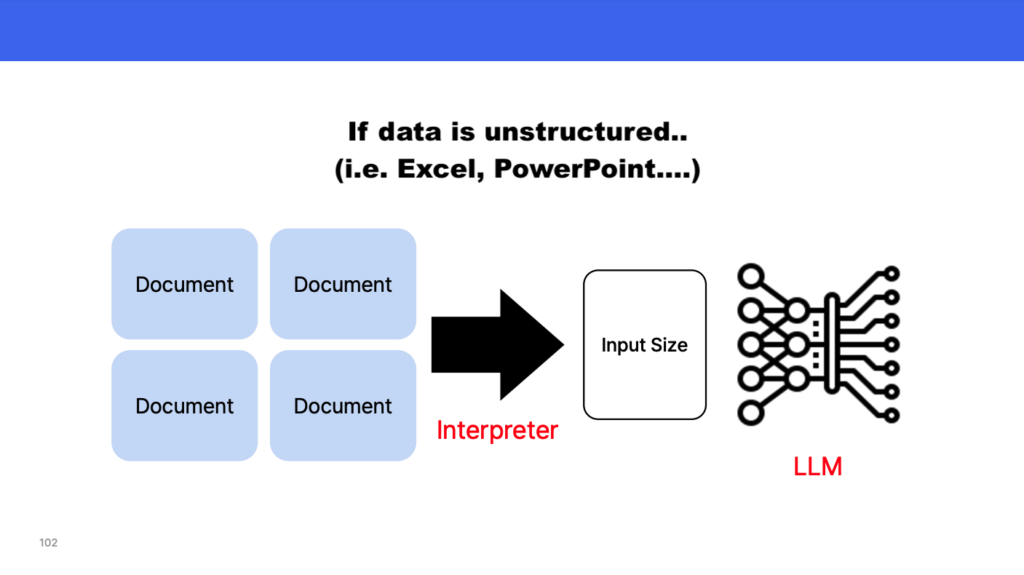What is Data Structuring?
In our previous article, we explored RAG (Retrieval-Augmented Generation) as a new approach to LLM training. RAG operates like an open-book test, utilizing external data to retrieve and generate accurate responses. The performance of RAG heavily depends on how effectively the data is structured.
Data structuring refers to the process of organizing and formatting data in a way that allows the model to quickly and accurately search, retrieve, and utilize relevant information.
Let’s dive deeper into how this works and why it’s so essential.
The Importance of Structured Data
The Limitations of Unstructured Data
When data is unorganized, it becomes challenging for an LLM to generate meaningful results.
For example, if a company’s internal documents exist in various formats—such as PDFs, Excel sheets, and text files—using them directly without proper structuring is not only inefficient but also increases the risk of inaccurate responses.

The Advantages of Structured Data
Structured data allows for faster retrieval of relevant information and more accurate selection of suitable data for generating responses.
Additionally, when updates are needed, structured data can be easily maintained and modified without disrupting the existing framework, ensuring long-term efficiency and scalability.
The Process of Structuring Data
In RAG, data structuring typically involves two key steps: Chunking and Embedding.
1. Chunking: Breaking Data into Smaller Units
Chunking is the process of dividing documents or data into smaller, meaningful units to make them easier to search and utilize.
Documents stored in formats like PDFs or Excel sheets are broken into smaller pieces.
These chunks help AI understand and process data more effectively.
Well-executed chunking improves search accuracy and response quality.
2. Embedding: Converting Data into Numbers
Since AI models operate on numerical data, text must be converted into numerical representations, known as embeddings.
For example, the word “Everest” might be transformed into a vector like [0.23, -0.11, 0.98]. These numerical vectors are then stored in a vector database.
- Vector Database and Search
When a question is entered, it is also converted into an embedding (a numerical vector). The model compares the question vector with the stored data vectors to find the most relevant matches. This comparison is typically done using methods like cosine similarity—the closer the score is to 1, the higher the similarity. The AI then generates a response based on the most similar data vectors.
The better the data structuring, the faster and more accurate the AI’s responses will be. Proper chunking and embedding are essential for optimizing the RAG system’s performance.
Trade-offs in Data Structuring Methods
Short Paragraphs vs. Long Paragraphs
Short Paragraphs:
Pros: Increase the likelihood of retrieving specific, relevant information tied to a query.
Cons: Overly fragmented data can make it harder to understand connections between pieces, and processing time may increase.
Long Paragraphs:
Pros: Provide broader context, making it easier to grasp the overall meaning.
Cons: May include irrelevant details, reducing retrieval accuracy.
Key Takeaway: Finding the right balance between short and long paragraphs is crucial for optimizing both relevance and context.
Structuring Based on Document Characteristics
Imagine a user asks, “What factors affect loan interest rates?”
Short Paragraphs: If the document is excessively fragmented, critical information about interest rates might be scattered, and the AI could miss key details.
Long Paragraphs: If the document is grouped as one cohesive unit, the AI can pull all relevant information at once, leading to a more accurate response.
Conclusion: The optimal structuring approach depends on the content and nature of the document. Tailoring the method to match the document’s characteristics ensures more accurate and context-aware results.
Structuring Methods and Consulting
The choice of structuring methods varies depending on the document’s characteristics and the specific needs of the client. This is why tailored consulting services are essential when adopting AI solutions.
For example:
“This document should be divided this way for optimal results.”
“Structuring it in this manner will cost approximately this much and take this amount of time.”
RAG goes beyond simple AI implementation—it serves as a powerful tool combining domain expertise with AI capabilities. However, the success of this integration hinges on how effectively the data is structured.
In our next article, we’ll dive into data chunking strategies for RAG and explore real-world use cases. Expect a closer look at Agentic Chunking and graph-based structuring approaches—key techniques for maximizing AI performance. Stay tuned!



